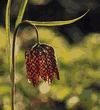- fritillary
-
/frit"l er'ee/, n., pl. fritillaries.any of several orange-brown nymphalid butterflies, usually marked with black lines and dots and with silvery spots on the undersides of the wings.[1625-35; < NL; see FRITILLARIA]
* * *
IAny of the approximately 80 species of bulbous, mostly perennial, ornamental herbaceous plants that make up the genus Fritillaria, in the lily family, native primarily to the northern temperate zone.Members have bell-shaped, nodding, usually solitary flowers. In many species the flower has a checkered appearance. The fruit, a capsule, contains many seeds. Snake's head, or toad lily (F. meleagris), a species with poisonous bulbs, and crown imperial (F. imperialis), a strong-smelling plant, are commonly cultivated as garden flowers. Snake's head (Fritillaria meleagris)Ingmar HolmasenIIName applied to butterflies in several genera (family Nymphalidae).Large fritillaries, or silverspots, belong to the genus Speyeria and usually have silver markings on the undersides of their wings. Many of the smaller fritillaries are members of the genus Boloria. Many fritillary larvae are nocturnal and feed on violet leaves.
Snake's head (Fritillaria meleagris)Ingmar HolmasenIIName applied to butterflies in several genera (family Nymphalidae).Large fritillaries, or silverspots, belong to the genus Speyeria and usually have silver markings on the undersides of their wings. Many of the smaller fritillaries are members of the genus Boloria. Many fritillary larvae are nocturnal and feed on violet leaves.* * *
▪ plantany ornamental plant of the genus Fritillaria of the family Liliaceae, consisting of about 80 species of bulbous, mostly perennial herbs, native primarily to the North Temperate Zone. Members of the genus have bell-shaped, nodding flowers that usually are solitary. The leaves alternate along the stem or are in whorls. A nectar gland is present at the base of each of the six parts of the flower.In many species the flower has a checkered appearance. The fruit is a three-valved capsule with many seeds. Snake's head, or toad lily (F. meleagris), a species with poisonous bulbs, and crown imperial (F. imperialis), a strong-smelling plant, are commonly cultivated as garden flowers.* * *
Universalium. 2010.
